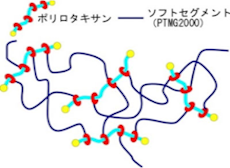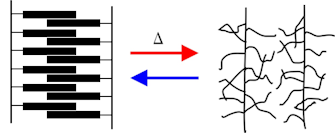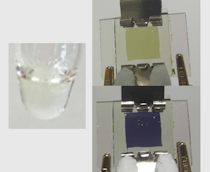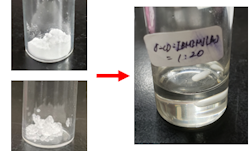Research topics
Polyrotaxane-Crosslinked Polyurethane

Polyrotaxane-crosslinked polyurethane is a polymeric material in which polyrotaxane (PRX) serves as the crosslinking point of polyurethane (PU). PRX has a unique structure in which cyclic molecules are threaded onto a linear axis molecule, and the mechanical interlocking of these components forms the crosslinks between PU chains. Thanks to this architecture, the material can exhibit stress relaxation and high elongation at break—properties that are difficult to achieve with conventional chemical crosslinking between polyurethane chains. In our laboratory, we focus on this polyrotaxane-based structure to improve the thermal and mechanical properties of polyurethane materials.
Functional Development of Side-Chain Crystalline Polymers (Adhesives)

Side-chain crystalline polymers are polymers that possess crystallizable units in their side chains. A key feature of these materials is their ability to undergo reversible order–disorder transitions in response to temperature changes. At low temperatures, the side chains crystallize, resulting in a rigid material. In contrast, at higher temperatures, the side chains become amorphous, leading to increased flexibility and adhesive properties. This thermoresponsive behavior makes such polymers promising for applications in temperature-sensitive adhesives and pressure-sensitive adhesives. Our laboratory is working on the functional development of side-chain crystalline polymers that exhibit temperature-dependent structural transitions.
Development of Redox-Active Ionic Liquids (RAILs)

Redox-active ionic liquids (RAILs) are ionic liquids in which at least one of the constituent ions possesses redox activity. Due to their high ionic concentration, RAILs not only conduct ions but also exhibit electronic conductivity via intramolecular self-exchange electron transfer reactions. A distinctive feature of RAILs is that they do not require supporting electrolytes, meaning that the mobility of redox-active ions directly influences the electrochemical response. In our laboratory, we are conducting research on the development of RAILs, their charge transport mechanisms, and their applications in electrochemical devices.
Functional Development of Deep Eutectic Ionic Liquids

Deep eutectic ionic liquids are liquid materials formed by mixing two or more components—each with relatively high melting points—that result in a significantly depressed freezing point. At least one of the components must be an ionic species. While they exhibit ionic conductivity similar to that of conventional ionic liquids, they can be synthesized from much less expensive starting materials. Due to their combination of hydrophobic and hydrophilic characteristics, deep eutectic ionic liquids also show promise as functional solvents. In our laboratory, we are exploring deep eutectic ionic liquids as a strategy for concentrating functional materials and for developing functional composite materials.







